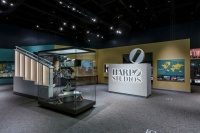Media Contact(s):
Jermaine House (202) 633-9495; housej@si.edu
Shrita Hernandez (202) 633-5089; hernandezs@si.edu
Fleur Paysour (202) 633-4761; paysourf@si.edu
Exhibition Looks at How America Shaped Oprah and How She Shaped America
(Black PR Wire) Washington, D.C. -- “Watching Oprah: The Oprah Winfrey Show and American Culture,” opens June 8 at the Smithsonian’s National Museum of African American History and Culture, and continues through June 2019. The exhibition will use the story of Winfrey and her 25-year daytime talk show as a lens to explore contemporary American history and culture, especially issues of power, gender and the media. It will feature video clips on a range of subjects, interactive interviews with Winfrey, costumes from her films Beloved and The Color Purple and artifacts from Harpo Studios in Chicago, home of The Oprah Winfrey Show.
“This exhibition examines the power of television,” said Lonnie G. Bunch III, the museum’s founding director. “Just as Oprah Winfrey watched TV coverage of the civil rights movement and was shaped by the era in which she was born and raised, she has gone on to have a profound effect on how Americans view themselves and each other in the tumultuous decades that followed. She has a place in the museum with a long line of women who did extraordinary things in their time—Harriet Tubman, Sojourner Truth, Ida B. Wells, Maya Angelou—women who worked to redeem the soul of America.”
Winfrey was awarded the Presidential Medal of Freedom, won seven Daytime Emmy Awards for Outstanding Talk Show Host, received the Golden Globe Cecil B. DeMille Award and is the nation’s first self-made African American female billionaire. This new Smithsonian exhibition probes the way in which America shaped Winfrey and how Winfrey’s work has shaped America.
The exhibition is in three sections: America Shapes Oprah, 1950s–1980s, The Oprah Winfrey Show and Oprah Shapes America. Museum curators Rhea L. Combs and Kathleen Kendrick put Winfrey’s story into context for visitors: “During her 25 years on broadcast television, her remarkable ability to connect in a familiar way with diverse audiences was crucial to her success. Many of the values she espoused on her show—including empowerment, education, spirituality and philanthropy—were rooted in her African American identity and upbringing.”
In the first section, America Shapes Oprah, key events in Winfrey’s life are considered in relationship to the broader political, social and cultural changes happening in the country. Artifacts include items from Winfrey’s childhood when she was deeply affected by the working women in her life, as well as artists, authors and activists whose works gave voice to the experiences of African American women. Among the highlights: the high school diploma earned by Carlotta Walls, one of the “Little Rock Nine” who integrated Central High School in Arkansas in 1957; a pennant carried by Edith Lee Payne, a 12-year-old girl from Detroit, at the 1963 March on Washington for Jobs and Freedom; images of women activists, including Pauli Murray, an attorney and Episcopal priest who helped organize the March on Washington, and Congresswoman Shirley Chisholm; and works by artist Elizabeth Catlett.
The exhibition also examines the evolution of The Oprah Winfrey Show, which dominated daytime TV from 1986 through 2011. Watched by millions in 145 countries, the show won 48 Daytime Emmy Awards, and featured a wide range of celebrities and challenging, rarely discussed topics such as beauty, relationships, sexual abuse and current affairs. Winfrey herself received a Daytime Emmy Lifetime Achievement Award in 1998.
The exhibition comes full circle with a section titled Oprah Shapes America. It explores Winfrey’s global influence that extends far beyond the world of TV, journalism and entertainment. The phenomenon of “The Oprah Effect”—Winfrey’s ability to shape public opinion and change people’s lives—has long been a subject of fascination and debate; it has raised important questions about the relationship between race, gender and power and about whose voices deserve to be heard and whose perspectives and experiences matter.
“Watching Oprah” is located in the museum’s Special Exhibitions gallery, a 4,300-square-foot exhibition space located on the concourse level near the elevator that takes visitors to the first level of the History Galleries. The exhibition is supported by MGM Resorts International, Target, Bank of America, and FedEx Corporation. The public can join the online conversation using #WatchingOprah and explore the exhibition online at www.nmaahc.si.edu/watchingoprah.
About the National Museum of African American History and Culture
The National Museum of African American History and Culture opened Sept. 24, 2016, on the National Mall in Washington, D.C. Occupying a prominent location next to the Washington Monument, the nearly 400,000-square-foot museum is the nation’s largest and most comprehensive cultural destination devoted exclusively to exploring, documenting and showcasing the African American story and its impact on American and world history. For more information about the museum, visit nmaahc.si.edu, follow @NMAAHC on Twitter, Facebook, Instagram and Snapchat.
# # #

